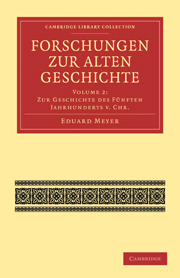Book contents
- Frontmatter
- Vorwort
- Inhalt
- I Die Biographie Kimons
- II Zur Geschichte der attischen Finanzen im fünften Jahrhundert
- III Wehrkraft, Bevölkerungszahl und Bodencultur Attikas
- IV Herodots Geschichtswerk
- V Thukydides
- VI Chronologische Untersuchungen. Die Regierungszeiten der persischen und der spartanischen Könige
- VII Zur Rechtfertigung des zweiten Bandes meiner Geschichte des Alterthums
- Index
II - Zur Geschichte der attischen Finanzen im fünften Jahrhundert
Published online by Cambridge University Press: 03 May 2011
- Frontmatter
- Vorwort
- Inhalt
- I Die Biographie Kimons
- II Zur Geschichte der attischen Finanzen im fünften Jahrhundert
- III Wehrkraft, Bevölkerungszahl und Bodencultur Attikas
- IV Herodots Geschichtswerk
- V Thukydides
- VI Chronologische Untersuchungen. Die Regierungszeiten der persischen und der spartanischen Könige
- VII Zur Rechtfertigung des zweiten Bandes meiner Geschichte des Alterthums
- Index
Summary
I. Der auf der beiliegenden Tafel) abgedruckte von Kallias beantragte Volksbeschluss CIA I, 32 (DS 14.21) enthält eine Reihe grundlegender Bestimmungen für die Erkenntniss des attischen Finanzwesens im fünften Jahrhundert. Gefunden ist der Stein als Altartafel in einer Kirche des Dorfes Charvati zwischen Hymettos und Pentelikon; jetzt wird er im Louvre bewahrt. Die Vorderseite ist fast vollständig erhalten, die Rückseite dagegen stark abgerieben und nur theilweise lesbar. So wichtig der Text ist, so schwierig ist seine richtige Interpretation und seine Verwerthung für die Geschichte. Er ist oft behandelt worden; seiner Zeit stand er bekanntlich im Mittelpunkt des Streits zwischen G. HERMANN und BOECKH und hat erwiesen, dass auch in diesen Dingen, soweit es sich um Reconstruction und richtige Interpretation einer Urkunde handelt, die „Sprachphilologie‟ eine sicherere Führerin ist als die „Sachphilologie‟.
Besondere Schwierigkeiten hat seine chronologische Ansetzung geboten. Da das Protokoll nur Prytanie, Grammateus und Epistates nennt, ist er fitr uns undatirt. Die jüngere Sprachform ταμαιs (nur auf der Ruckseite Zl. 52 ταμιασι) und die Schreibung σuv statt χσuv lehren, dass die Urkunde nicht vor dem Ende des archidamischen Kriegs in Stein gehauen sein kann. In diese Zeit, in die Jahre 419/8 und 418/7, glaubte BOECKH) denn auch die beiden Beschlüsse der Vorder- und Rückseite setzen zu können; schien doch die Angabe, dass dem Schatz der Athena 3000 Talente gezahlt seien, und die Anordnung, jetzt die Anleihen bei den andern Göttern zurückzuzahlen, vortrefflich in die Zeit naeh dem Nikiasfrieden zu passen.
- Type
- Chapter
- Information
- Forschungen zur Alten Geschichte , pp. 88 - 148Publisher: Cambridge University PressPrint publication year: 2010First published in: 1899



